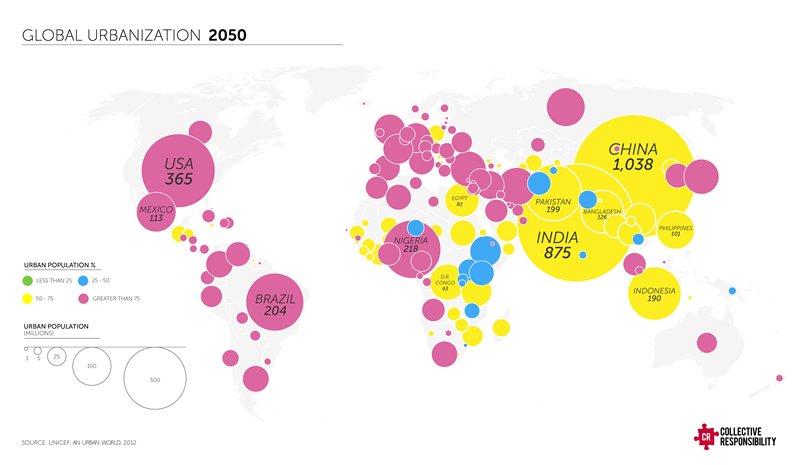Reframing Sustainability For Future Cities
 For the first time ever (as of 2012) more people – over 700 million – live in China’s urban areas than in its rural regions. By 2020, about 60% of China’s population will live in cities; and 300 million urban residents are expected to move into its urban centers by 2030. Along with this shift to a more urban population comes a dramatic change in lifestyle: from a subsistence level or an agrarian focus to a consumption-focused lifestyle.
For the first time ever (as of 2012) more people – over 700 million – live in China’s urban areas than in its rural regions. By 2020, about 60% of China’s population will live in cities; and 300 million urban residents are expected to move into its urban centers by 2030. Along with this shift to a more urban population comes a dramatic change in lifestyle: from a subsistence level or an agrarian focus to a consumption-focused lifestyle.
Sustainability in China has been a topic of many conversations for years now. The failure of China and the US to come to agreement in Copenhagen in December 2009 focused even more attention on the topic. It is a story that has been about smoggy skies and polluted skies, and as the challenges have grown, calls for a different model have grown louder. It is a story that has gained more steam over the last several years as urban residents have become more numerous, grown wealthy, and are increasingly impatient with the smog.
On February 28, Chai Jing, one of China’s most famous television journalist and a best-selling author, released a self-financed documentary aiming to unveil the root causes of China’s notoriously polluted air. The 103-minute video quickly went viral, and within days of its release it had been viewed more than 200 million times. Some began calling Ms. Chai China’s Rachel Carson, an American activist whose book The River Runs Black was seen as a turning point in America’s environmental movement. Others compared the video to Al Gore’s An Inconvenient Truth.
For many foreign firms operating in China, this change in dynamic has often been seen as a threat as regulatory bodies and their enforcement arms have increased their efforts to curb pollutants. For others, the changing dynamic has been a source of hope. It’s a sign that China’s new markets for green energies, building materials, and electric vehicles – which are growing faster than anywhere else in the world – are being driven by a wider body of stakeholders that are accepting that China’s environment is failing and that change needs to happen. Change is beginning to take place. A change that, if made, will over the coming decades see the development of sustainable urban environments becoming one of the greatest economic opportunities of our lifetime .
Looking at the issues of sustainability in the context of China today, it is of primary importance for outsiders to understand the following:
- Historically, China’s issues of sustainability were not linked mainly to private consumption, as they are in the United States or Western Europe; they were linked to the industrial processes that are supporting China’s economic development model.
- China does not see emissions as a “problem” that must be dealt with immediately . With economic growth still the priority , the country’s concerns with sustainability are focused on accessing and managing the resources that its cities will need to grow, while reducing the emissions that are contaminating its air, water, and soil.
- The largest pressure China faces to solve sustainability issues will continue to come from within, as the next 25 years of growth will come from another 300 million moving to the city .
Simply put, the issues that China faces are largely tied to economic development , the problems themselves are growing in size and frequency, and China will do what it takes to fix those problems in a way that considers the needs of its people first. These are also issues that will continue to be faced by India, Brazil, Nigeria, and the next generation of cities that will go through hyper-development over the next 25 years. Leaders need to stop seeing sustainability in China as a threat to doing business , and begin seeing it as an opportunity to develop a portfolio of products and services that will support the urban centers supporting billions.
Areas where there are immediate opportunities and need:
- Urban Planning – At the core of a sustainable city is the urban planning, and sustainable cities are often viewed as the only way that a population of 10 billion people on Earth could be sustained. They need to be dense. They need to be efficient with resources. But more importantly they need to be places where people want to live, raise children, and invest in their communities.
- Energy distribution and efficiency – While the focus of many conversations in the energy industry is around cleaner energy supply, for China the real need is to drive efficiency through the grid – a grid that requires up to three times the amount of energy it takes Western markets to create one unit of GDP.
- Food safety – Whether it is through the acquisition of firms like Smithfield Foods, or through partnerships with IMB to create pork traceability programs, one of the key areas for improving the urban economy will be through food . With an estimated 40-60% of China’s food lost before it reaches the tables of its consumers , it is an industry whose inefficiencies begin on the farm and continue through the entire food chain .
- Accessible and affordable healthcare – With China’s population graying, and its urban environments struggling to provide care to its sick and aged, mayors around the country are already looking to industry to bring solutions that build on top of the government’s own capacity to build care facilities .
- Efficient Transportation – As consumer demand for private vehicles continues to rise, a variety of alternatives are being developed to address the challenges. The automotive industry is focusing on broad innovations (including electro-mobility) to decrease fuel consumption and reduce the emissions of public and private vehicles. At the same time, advances in technology and investments in infrastructure have the opportunity to make public transport a more viable, efficient alternative.
- Waste Management – As China’s material consumption continues to increase, the level of waste production will only increase the amount of organic and inorganic waste that is entering landfills every day.
Where this gets exciting for those in China, is that once a product or service’s pilot project has proven itself in China, there will be an opportunity to scale to the country’s needs through the markets of India, Brazil, Indonesia, and Nigeria . These are the cities of the futures for hyper-urbanization, and will be critical players in a world where there are 6 billion urban consumers looking to live the “American Dream”. It’s a dream that is only possible through a new model, one that will be sketched out in China and fine-tuned over the next 35 years.

